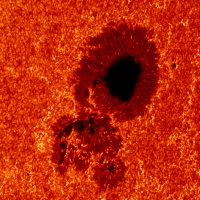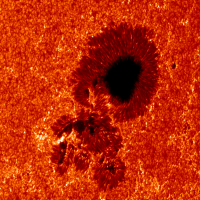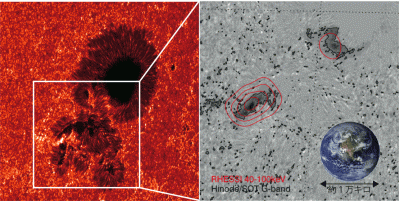"Hinode" discovers the origin of white-light flare emission
Japan Aerospace Exploration Agency (JAXA)
National Astronomical Observatory of Japan (NAOJ/NINS)
National Aeronautics and Space Administration (NASA)
Science and Technology Facilities Council (STFC)
European Space Agency (ESA)
A Japan-US international research team led by Dr. Kyoko Watanabe, a JAXA aerospace project research associate, has identified the origin of the white-light emission in solar flares, by quantitatively analyzing an X-class solar flare. This flare was successfully observed by two solar observing satellites: JAXA launched "Hinode" and NASA's RHESSI. The origin of the white light emission has not yet been clarified since its first discovery about 150 years ago. This finding is published in the May 20, 2010 issue of the Astrophysical Journal.
A "solar flare" is the most energetic explosion in the solar system. X-rays, radio, and chromospheric spectral lines (Ha etc) are primarily used to observe flares. The most powerful flares may be recognized as brightenings in visible light, which can be also seen by the human eye, and thus they are specially called "white light" flares. Richard Carrington, a UK amateur astronomer, made the first observation of solar flares in 1859 while sketching details of sunspots; the bright features he recognized in the neighborhood of his sunspots at that time correspond to white-light emissions. However, the occurrence of such white-light emission is very infrequent and thus the mechanism creating the white light emissions has remained unclear for a long time. The Solar Optical Telescope onboard the solar observing satellite "Hinode," which was launched on 23 September 2006 by JAXA in collaboration with the listed agencies, provides precise white-light images, allowing scientists to study this phenomenon in quantitative detail for the first time. The Hinode observations suggest that many flares are accompanied by white-light emissions.
White-light emission was observed by the Solar Optical Telescope, when an X-class flare occurred at 22:09 UT on 14 December 2006 (Fig. 1). The RHESSI satellite simultaneously recorded hard X-ray emissions, which are the indicator of non-thermal electrons highly accelerated by solar flares. The team found that the spatial location and temporal change of white light emissions were well-correlated with those of hard X-ray emissions (Fig. 2). Moreover, the energy of the white-light emissions is equivalent to the energy supplied by all the electrons accelerated to above 40 keV (~40% of the speed of light). This finding strongly suggests that highly accelerated electrons are responsible for producing white light emissions.
Hard X-rays are emitted when accelerated electrons impinge on the dense atmosphere near the solar surface . Normally, white light primarily comes from the solar surface, whereas 40 keV electrons accelerated in the corona can only penetrate down to about 1,000 km above the solar surface, i.e., the chromosphere. There is a thus big discrepancy in emission height. The new finding therefore calls attention to the need for a white-light emission model that can explain the good correlation with high-energy electron emission and difference of the emission height of white light and hard X-rays.
Particle acceleration is the one of the mysteries in solar flares. Modeling energy transfer of high-energy particles in solar atmosphere is the most important subject for further improving the knowledge of particle acceleration. Highly accelerated particles may travel toward the Earth and cause geomagnetic storms, resulting in severe influences on human activities. Now solar activity is gradually rising again after an unusually long silent period, and solar physicists are hoping that "Hinode" will now increase our opportunities to observe solar flares and give new insight.
  |

Published paper information:
Title: "G-band and Hard X-ray Emissions of the 2006 December 14 Flare Observed by Hinode/SOT and RHESSI" by
Kyoko Watanabe (Institute of Space and Astronautical Science[ISAS], JAXA), Sam Krucker, Hugh Hudson (Space Science Laboratories, University of California, Berkeley), Toshifumi Shimizu (ISAS/JAXA), Satoshi Masuda (Nagoya University), Kiyoshi Ichimoto (Kyoto University)
The Astrophysical Journal, No.715, pp. 651-655, 2010.
Regarding the use of images and movies on the page concerned, please visit the page here. The credits of images and movies on this page are “NAOJ/JAXA” unless explicitly stated to the contrary. Regarding images and movies on this page the credits of which are “NAOJ/JAXA”, "NAOJ/JAXA/MSU", or “NAOJ, JAXA, NASA/MSFC”, terms of use for Copyrighted Works owned by NAOJ can be applied. In using the images and movies, the credits should be given.
